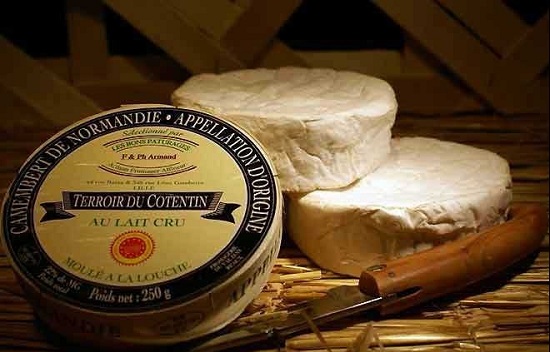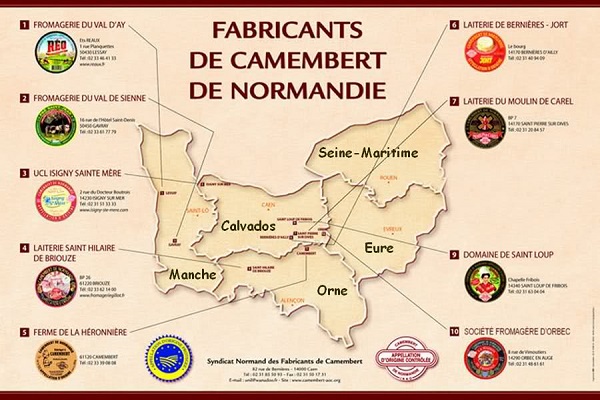
Camembert is probably the nost well known of all French cheeses and the name and technique have been copied all over the world. The French AOC Camembert de Normandie is widely considered the benchmark by which all others are judged, but despite its reputation as a proud symbol of a national cheese-making skill, it is a surprisingly new cheese compared with such classics as Roquefort, Cantal and Brie de Meaux. In fact, its fame is largely due to its success as an industrial cheese produced by hundreds of cooperative dairies that sprung up in Normandy little more than a century ago.
According to a popular account written in 1926 by an American doctor and devotee of his cheese, Camembert was invented by a young farmer’s wife named Marie Harel after she helped a priest escaping the French Revolution. The priest came from Meaux, a town in the Brie region, and, in gratitude for his safety, he is said to have shared the secret of how to grow the unique mould used to mature the traditional cheeses made there since the 15th century.
Whatever the truth of this story, there is no recorded association between the small village of Camembert and cheese until Napoleon III opened a new railway network linking Normandy to Paris in 1863. When presented with an unknown farm cheese, he is said to have politely asked where it came from, and Camembert was the reply. The new railway meant that Normandy’s cheese and butter could reach the growing Parisian markets in just six hours instead of the four days it took over bumpy roads by horse and coach. But Camembert was almost certainly considered too fragile to transport over such long distances in the layers of straw commonly used for packing soft cheese at that time. According to Pierre Boisard’s book Camembert: a National Myth it was not until the 1890s that a small wooden box revolutionized the name of Camembert.
The box was commonly used by chemists until an engineer by the name of Ridel came up with the brilliant idea of adapting it for cheese. For the first time it enabled Camembert to travel long distances and, coincidentally created a unique microclimate in which it could mature. Its small size had the added advantage of making the cheese easy to store at home until perfectly ripe, and provided a marketing opportunity to clearly identify the name, place of origin and producer.
Significant improvements in refrigeration and cheese-making techniques, including the introduction of new white surface-ripening moulds, were to follow and by the 1920s Normandy Camembert was being sold in all major cities in France, other parts of Europe and even the US. But despite many attempts by French producers to protect the name and origin, it took until 1983 for them all to agree on regulations for the production of “Camembert de Normandie” using raw milk collected from a strictly defined area of Normandy under the system of AOC. Size was limited to an 11cm round cheese weighing 250g, and the finest examples were wrapped in wax paper and then packed in the distinctive wooden box.
Camembert de Normandie is found in the dairy cases of all major supermarkets and specialist cheese shops in Europe, but examples of this benchmark cheese are banned from sale in Australia because of strict national food standards. Recent innovations in starter technology, however, had made it possible to partially replicate some of the characteristics that make genuine Camembert such a pleasure, using pasteurised milk.
So next time you have the opportunity to try Camembert du Normandie, and you must if you have that opportunity, think on this history and the little wooden box that holds it. It is said that this wonderful Camembert should always be paired with dry sparkling cider and crusty bread but for me, a picnic with a bottle of white wine, crusty fresh baguette and some cheese will do just fine!!










